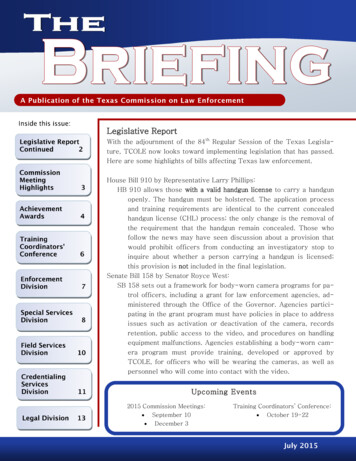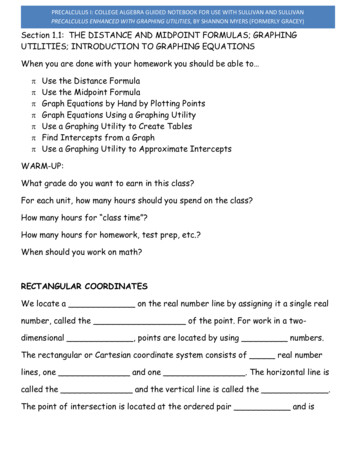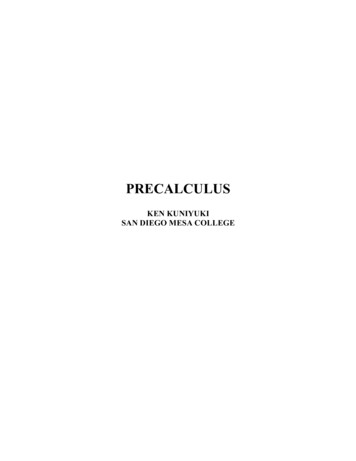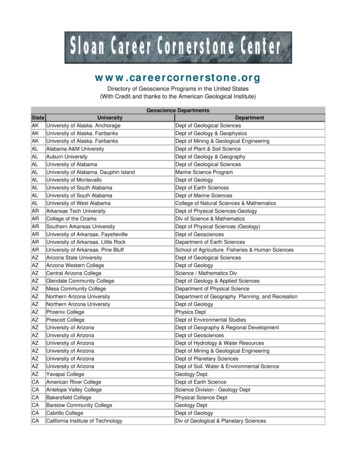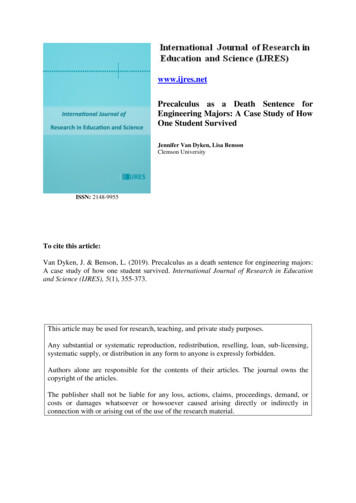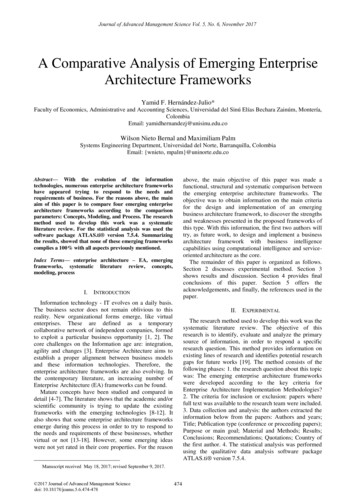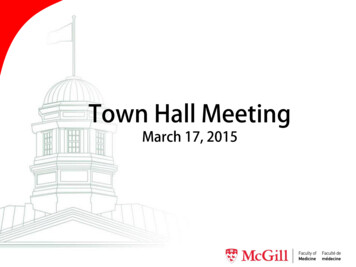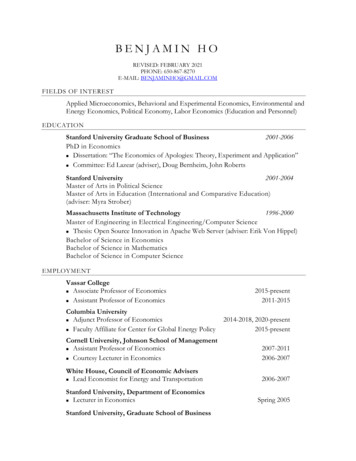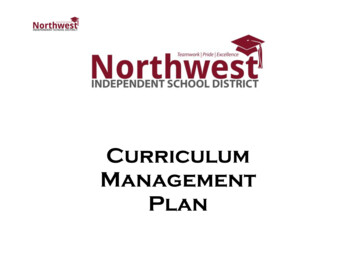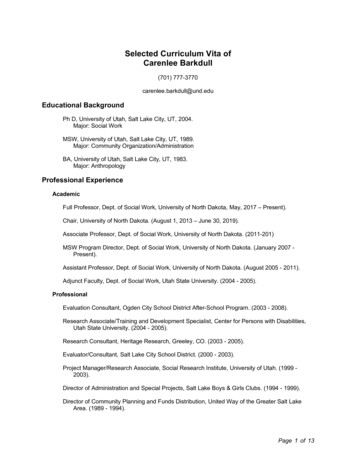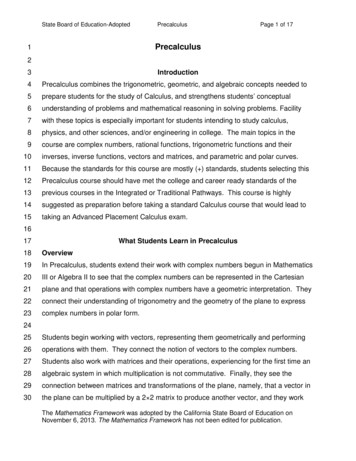
Transcription
State Board of Education-AdoptedPrecalculusPage 1 of 17Precalculus123Introduction4Precalculus combines the trigonometric, geometric, and algebraic concepts needed to5prepare students for the study of Calculus, and strengthens students’ conceptual6understanding of problems and mathematical reasoning in solving problems. Facility7with these topics is especially important for students intending to study calculus,8physics, and other sciences, and/or engineering in college. The main topics in the9course are complex numbers, rational functions, trigonometric functions and their10inverses, inverse functions, vectors and matrices, and parametric and polar curves.11Because the standards for this course are mostly ( ) standards, students selecting this12Precalculus course should have met the college and career ready standards of the13previous courses in the Integrated or Traditional Pathways. This course is highly14suggested as preparation before taking a standard Calculus course that would lead to15taking an Advanced Placement Calculus exam.1617What Students Learn in Precalculus18Overview19In Precalculus, students extend their work with complex numbers begun in Mathematics20III or Algebra II to see that the complex numbers can be represented in the Cartesian21plane and that operations with complex numbers have a geometric interpretation. They22connect their understanding of trigonometry and the geometry of the plane to express23complex numbers in polar form.2425Students begin working with vectors, representing them geometrically and performing26operations with them. They connect the notion of vectors to the complex numbers.27Students also work with matrices and their operations, experiencing for the first time an28algebraic system in which multiplication is not commutative. Finally, they see the29connection between matrices and transformations of the plane, namely, that a vector in30the plane can be multiplied by a 2 2 matrix to produce another vector, and they workThe Mathematics Framework was adopted by the California State Board of Education onNovember 6, 2013. The Mathematics Framework has not been edited for publication.
State Board of Education-AdoptedPrecalculusPage 2 of 1731with matrices from the point of view of transformations. They also find inverse matrices32and use matrices to represent and solve linear systems.3334Students extend their work with trigonometric functions, investigating the reciprocal35functions secant, cosecant, and cotangent and their graphs and properties. They find36inverse trigonometric functions by appropriately restricting the domains of the standard37trigonometric functions and use them to solve problems that arise in modeling contexts.3839While students have worked previously with parabolas and circles, they now work with40ellipses and hyperbolas. They also work with polar coordinates and curves defined41parametrically, and connect these to their other work with trigonometry and complex42numbers.4344Finally, students work with more complicated rational functions, graphing them and45determining zeros, y-intercepts, symmetry, asymptotes, intervals for which the function46is increasing or decreasing, and maximum or minimum points.4748Connecting Standards for Mathematical Practice and Content49The Standards for Mathematical Practice apply throughout each course and, together50with the content standards, prescribe that students experience mathematics as a51coherent, useful, and logical subject that makes use of their ability to make sense of52problem situations. The Standards for Mathematical Practice (MP) represent a picture53of what it looks like for students to do mathematics in the classroom and, to the extent54possible, content instruction should include attention to appropriate practice standards.55The table below gives examples of how students can engage in the MP standards in56Precalculus.57Standards forMathematical PracticeStudents MP1. Make sense ofproblems and persevere inExamples of each practice in PrecalculusStudents expand their repertoire of expressions and functions that can usedto solve problems. They grapple with understanding the connectionThe Mathematics Framework was adopted by the California State Board of Education onNovember 6, 2013. The Mathematics Framework has not been edited for publication.
State Board of Education-Adoptedsolving them.MP2. Reason abstractlyand quantitatively.MP3. Construct viablearguments and critique thereasoning of others.Students build proofs byinduction and proofs bycontradiction. CA 3.1 (forhigher mathematics only).MP4. Model withmathematics.MP5. Use appropriatetools strategically.MP6. Attend to precision.MP7. Look for and makeuse of structure.MP8. Look for and makeuse of regularity inrepeated reasoning.PrecalculusPage 3 of 17between complex numbers, polar coordinates, and vectors, and reasonabout them.Students understand the connection between transformations and matrices,seeing a matrix as an algebraic representation of a transformation of theplane.Students continue to reason through the solution of an equation and justifytheir reasoning to their peers. Students defend their choice of a function tomodel a real-world situation.Students apply their new mathematical understanding to real-worldproblems. Students also discover mathematics through experimentationand examining patterns in data from real-world contexts.Students continue to use graphing technology to deepen theirunderstanding of the behavior of polynomial, rational, square root, andtrigonometric functions.Students make note of the precise definition of complex number,understanding that real numbers are a subset of the complex numbers.They pay attention to units in real-world problems and use unit analysis as amethod for verifying their answers.Students understand that matrices form an algebraic system in which theorder of multiplication matters, especially when solving linear systems usingthem. They see that complex numbers can be represented by polarcoordinates, and that the structure of the plane yields a geometricinterpretation of complex multiplication.Students multiply several vectors by matrices and observe that somematrices give rotations or reflections. They compute with complex numbersand generalize the results to understand the geometric nature of theiroperations.5859MP standard 4 holds a special place throughout the higher mathematics curriculum, as60Modeling is considered its own conceptual category. Though the Modeling category61has no specific standards listed within it, the idea of using mathematics to model the62world pervades all higher mathematics courses and should hold a high place in63instruction. Readers will see some standards marked with a star symbol ( ) to indicate64that they are modeling standards, that is, they present an opportunity for applications to65real-world modeling situations more so than other standards. Note that this does not66preclude other standards from being taught with/through Mathematical Modeling.67The Mathematics Framework was adopted by the California State Board of Education onNovember 6, 2013. The Mathematics Framework has not been edited for publication.
State Board of Education-AdoptedPrecalculusPage 4 of 1768Examples of places where specific MP standards can be implemented in the69Precalculus standards will be noted in parentheses, with the specific practice70standard(s) indicated.717273Precalculus Mathematics Content Standards by Conceptual Category74The Precalculus course is organized by conceptual category, domains, clusters, and75then standards. Below, the general purpose and progression of the standards included76in Precalculus are described according to these conceptual categories. Note that the77standards are not listed in an order in which they should be taught.7879Conceptual Category: Modeling80Throughout the higher mathematics CA CCSSM, certain standards are marked with a81( ) symbol to indicate that they are considered modeling standards. Modeling at this82level goes beyond the simple application of previously constructed mathematics to real-83world problems. True modeling begins with students asking a question about the world84around them, and mathematics is then constructed in the process of attempting to85answer the question. When students are presented with a real-world situation and86challenged to ask a question, all sorts of new issues arise: which of the quantities87present in this situation are known and unknown? Students need to decide on a solution88path, which may need to be revised. They make use of tools such as calculators,89dynamic geometry software, or spreadsheets. They will try to use previously derived90models (e.g. linear functions) but may find that a new equation or function will apply.91They may see that solving an equation arises as a necessity when trying to answer their92question, and that oftentimes the equation arises as the specific instance of the knowing93the output value of a function at an unknown input value.9495Modeling problems have an element of being genuine problems, in the sense that96students care about answering the question under consideration. In modeling,97mathematics is used as a tool to answer questions that students really want answered.98This will be a new approach for many teachers and will be challenging to implement, butThe Mathematics Framework was adopted by the California State Board of Education onNovember 6, 2013. The Mathematics Framework has not been edited for publication.
State Board of Education-AdoptedPrecalculusPage 5 of 1799the effort will produce students who can appreciate that mathematics is relevant to their100lives. From a pedagogical perspective, modeling gives a concrete basis from which to101abstract the mathematics and often serves to motivate students to become independent102learners.103104105106Figure 1: The modeling cycle. Students examine a problem and formulate a mathematical model (anequation, table, graph, etc.), compute an answer or rewrite their expression to reveal new information,interpret their results, validate them, and report out.107108The reader is encouraged to consult the Appendix, “Mathematical Modeling,” for a109further discussion of the modeling cycle and how it is integrated into the higher110mathematics curriculum.111112Conceptual Category: Functions113The standards of the functions conceptual category can set the stage for the learning of114other standards in Precalculus. At this level, expressions are often viewed as defining115outputs for functions, and algebraic manipulations are then performed meaningfully with116an eye towards what can be revealed about the 0131132Interpreting FunctionsF-IFInterpret functions that arise in applications in terms of the context.4. For a function that models a relationship between two quantities, interpret key features of graphs and tables interms of the quantities, and sketch graphs showing key features given a verbal description of the relationship. Keyfeatures include: intercepts; intervals where the function is increasing, decreasing, positive, or negative; relativemaximums and minimums; symmetries; end behavior; and periodicity. 5. Relate the domain of a function to its graph and, where applicable, to the quantitative relationship it describes. Forexample, if the function h gives the number of person-hours it takes to assemble n engines in a factory, then thepositive integers would be an appropriate domain for the function. Analyze functions using different representations.7. Graph functions expressed symbolically and show key features of the graph, by hand in simple cases and usingtechnology for more complicated cases. 7d. ( ) Graph rational functions, identifying zeros and asymptotes when suitable factorizations are available, andshowing end behavior. The Mathematics Framework was adopted by the California State Board of Education onNovember 6, 2013. The Mathematics Framework has not been edited for publication.
State Board of Education-AdoptedPrecalculusPage 6 of 1491507e. Graph exponential and logarithmic functions, showing intercepts and end behavior, and trigonometric functions,showing period, midline, and amplitude. 10. ( ) Demonstrate an understanding of functions and equations defined parametrically and graph them.CA 11. ( ) Graph polar coordinates and curves. Convert between polar and rectangular coordinate systems. CA151domains appeared in previous courses, students now apply them in the cases of152polynomial functions of degree greater than two, more complicated rational functions,153the reciprocal trigonometric functions, and inverse trigonometric functions. Students154examine end behavior of polynomial and rational functions and learn how to find155asymptotes.Building FunctionsF-BFBuild new functions from existing functions.3. Identify the effect on the graph of replacing f(x) by f(x) k, k f(x), f(kx), and f(x k) for specific values of k (bothpositive and negative); find the value of k given the graphs. Experiment with cases and illustrate an explanation ofthe effects on the graph using technology. Include recognizing even and odd functions from their graphs andalgebraic expressions for them.4. Find inverse functions.b. ( ) Verify by composition that one function is the inverse of another.c. ( ) Read values of an inverse function from a graph or a table, given that the function has an inverse.d. ( ) Produce an invertible function from a non-invertible function by restricting the domain.While many of the standards in the Interpreting Functions and Building Functions156157Students further their understanding of inverse functions. Whereas before, students158only found inverse functions in simple cases (e.g. solving for 𝑥, when 𝑓(𝑥) 𝑐, finding159160inverses of linear functions), they now explore the relationship between two functionsthat are inverses of each other, i.e. that 𝑓 and 𝑔 are inverses if (𝑓 𝑔)(𝑥) 𝑥 and162(𝑔 𝑓)(𝑥) 𝑥, and they may begin to use inverse function notation, expressing 𝑔 as163given function and use inverses in contexts. Students in Precalculus understand how a164function and its domain and range are related to its inverse function. They realize that165finding an inverse function is more than just “switching variables” and solving an166equation. They can even find simpler inverses mentally, such as when they reverse the167“steps” for the equation 𝑓(𝑥) 𝑥 3 1 to realize that the inverse of 𝑓 must be 𝑓 1 (𝑥) 161168169𝑔 𝑓 1 . They construct inverse functions by appropriately restricting the domain of a3 𝑥 1.170Students study parametric functions in Precalculus, understanding that a curve in the171plane that might describe the path of a moving object can be represented with suchThe Mathematics Framework was adopted by the California State Board of Education onNovember 6, 2013. The Mathematics Framework has not been edited for publication.
State Board of Education-AdoptedPrecalculusPage 7 of 17172functions. Students also work with polar coordinates and graph polar curves.173Connections should be made between polar coordinates and the polar representation of174complex numbers (N-CN.4, 5). Students also discover the important role the175trigonometric functions play in working with polar coordinates. These standards are176new in the typical Precalculus curriculum. Students can investigate these new concepts177in modeling situations, such as by recording points on the curve a tossed ball travels178along, graphing the points as vectors, and deriving equations for 𝑥(𝑡) and 𝑦(𝑡). They179can also investigate the relationship between the graphs of the sine and cosine as180functions of 𝜃 on the one hand and the graph of the curve defined by 𝑥(𝜃) 7cos 𝜃, 𝑦(𝜃) sin 𝜃 on the other, drawing connections between the two.Trigonometric FunctionsF-TFExpand the domain of trigonometric functions using a unit circle.4. ( ) Use the unit circle to explain symmetry (odd and even) and periodicity of trigonometric functions.Model periodic phenomena with trigonometric functions.6. ( ) Understand that restricting a trigonometric function to a domain on which it is always increasing or alwaysdecreasing allows its inverse to be constructed.7. ( ) Use inverse functions to solve trigonometric equations that arise in modeling contexts; evaluate the solutionsusing technology, and interpret them in terms of the context. Prove and apply trigonometric identities.9. ( ) Prove the addition and subtraction formulas for sine, cosine, and tangent and use them to solve problems.10. ( ) Prove the half angle and double angle identities for sine and cosine and use them to solve problems.CA198In this set of standards, students expand their understanding of the trigonometric199functions by connecting properties of the functions to the unit circle, e.g., understanding200that since that traveling 2𝜋 radians around the unit circle returns one to the same point201on the circle, this must be reflected in the graphs of sine and cosine. Students extend202their knowledge of finding inverses to doing so for trigonometric functions, and use them203in a wide range of application problems.204205Students derive the addition and subtraction formulas for sine, cosine and tangent, as206well as the half angle and double angle identities for sine and cosine, and make207connections between among these. For example, students can derive from the addition208formula for cosine (cos(𝑥 𝑦) cos 𝑥 cos 𝑦 sin 𝑥 sin 𝑦) the double angle formula for209cosine:The Mathematics Framework was adopted by the California State Board of Education onNovember 6, 2013. The Mathematics Framework has not been edited for publication.
State Board of Education-AdoptedPrecalculusPage 8 of 17cos 2𝑥 cos(𝑥 𝑥) cos 𝑥 cos 𝑥 sin 𝑥 sin 𝑥 cos2 𝑥 sin2 𝑥.210Another opportunity for connections arises here, as students can investigate the211relationship between these formulas and complex multiplication.212213Conceptual Category: Number and Quantity214The Number and Quantity standards in Precalculus represent a culmination in students’215understanding of number systems. Students investigate the geometry of the complex216numbers more fully and connect it to operations with complex numbers. In addition,217students develop the notion of a vector and connect operations with vectors and218matrices to transformations of the 3234235The Complex Number SystemN–CNPerform arithmetic operations with complex numbers.3. ( ) Find the conjugate of a complex number; use conjugates to find moduli and quotients ofcomplex numbers.Represent complex numbers and their operations on the complex plane.4. ( ) Represent complex numbers on the complex plane in rectangular and polar form (including real andimaginary numbers), and explain why the rectangular and polar forms of a given complex numberrepresent the same number.5. ( ) Represent addition, subtraction, multiplication, and conjugation of complex numbers geometrically on3the complex plane; use properties of this representation for computation. For example, (–1 3 i) 8because (–1 3 i) has modulus 2 and argument 120 .6. ( ) Calculate the distance between numbers in the complex plane as the modulus of the difference,and the midpoint of a segment as the average of the numbers at its endpoints.236As mentioned earlier, complex numbers, polar coordinates, and vectors should all be237taught with an emphasis on connections between them. For instance, students connect238the addition of complex numbers to the addition of vectors; they also investigate the239geometric interpretation of multiplying complex numbers and connect it to polar240coordinates using the polar ctor and Matrix QuantitiesN–VMRepresent and model with vector quantities.1. ( ) Recognize vector quantities as having both magnitude and direction. Represent vector quantities by directedline segments, and use appropriate symbols for vectors and their magnitudes (e.g., v, v , v , v).2. ( ) Find the components of a vector by subtracting the coordinates of an initial point from the coordinates of aterminal point.3. ( ) Solve problems involving velocity and other quantities that can be represented by vectors.Perform operations on vectors.4. ( ) Add and subtract vectors.The Mathematics Framework was adopted by the California State Board of Education onNovember 6, 2013. The Mathematics Framework has not been edited for publication.
State Board of Education-AdoptedPrecalculusPage 9 of 268269270271272273274275276277278a. Add vectors end-to-end, component-wise, and by the parallelogram rule. Understand that the magnitude of asum of two vectors is typically not the sum of the magnitudes.b. Given two vectors in magnitude and direction form, determine the magnitude and direction of their sum.c. Understand vector subtraction v – w as v (–w), where –w is the additive inverse of w, with the samemagnitude as w and pointing in the opposite direction. Represent vector subtraction graphically by connectingthe tips in the appropriate order, and perform vector subtraction component-wise.5. ( ) Multiply a vector by a scalar.a. Represent scalar multiplication graphically by scaling vectors and possibly reversing their direction; performscalar multiplication component-wise, e.g., as c(v x , v y ) (cv x , cv y ).b. Compute the magnitude of a scalar multiple cv using cv c v. Compute the direction of cv knowing thatwhen c v 0, the direction of cv is either along v (for c 0) or against v (for c 0).279Students investigate vectors as geometric objects in the plane that can be represented280by ordered pairs, and matrices as objects that act on vectors. Through working with281vectors and matrices both geometrically and quantitatively, students discover that vector282addition and subtraction behave according to certain properties, while matrices and283matrix operations observe their own set of rules. Attending to structure, students284discover with matrices a new set of mathematical objects and operations among them285that has a multiplication that is not commutative. They find inverse matrices by hand in2862 2 cases and using technology in other cases. Work with vectors and matrices here287Perform operations on matrices and use matrices in applications.6. ( ) Use matrices to represent and manipulate data, e.g., to represent payoffs or incidence relationships in anetwork.7. ( ) Multiply matrices by scalars to produce new matrices, e.g., as when all of the payoffs in a game are doubled.8. ( ) Add, subtract, and multiply matrices of appropriate dimensions.9. ( ) Understand that, unlike multiplication of numbers, matrix multiplication for square matrices is not a commutativeoperation, but still satisfies the associative and distributive properties.10. ( ) Understand that the zero and identity matrices play a role in matrix addition and multiplication similar to therole of 0 and 1 in the real numbers. The determinant of a square matrix is nonzero if and only if the matrix has amultiplicative inverse.11. ( ) Multiply a vector (regarded as a matrix with one column) by a matrix of suitable dimensions to produceanother vector. Work with matrices as transformations of vectors.12. ( ) Work with 2 2 matrices as transformations of the plane, and interpret the absolute value of the determinantin terms of area.sets the stage for solving systems of equations in the Algebra conceptual category.288289Conceptual Category: Algebra290In the Algebra conceptual category, Precalculus students work with higher degree291polynomials and more complicated rational functions. As always, they attend to the292meaning of the expressions they work with, and the expressions they encounter often293arise in the context of functions. As in all other Higher Mathematics courses, studentsThe Mathematics Framework was adopted by the California State Board of Education onNovember 6, 2013. The Mathematics Framework has not been edited for publication.
State Board of Education-AdoptedPrecalculusPage 10 of 17294work with creating and solving equations, and do so in contexts connected to real-world295situations through 9310311312313314Seeing Structure in Expressions315By the time students are taking Precalculus, they should have a well-developed316understanding the concept of a function. To make work with rational expressions more317meaningful, students should be given opportunities to connect rational expressions to318rational functions, (whose outputs are defined by the expressions). For example, a319traditional exercise with rational expressions might have the following form:A-SSEInterpret the structure of expressions.1. Interpret expressions that represent a quantity in terms of its context. a. Interpret parts of an expression, such as terms, factors, and coefficients.b. Interpret complicated expressions by viewing one or more of their parts as a single entity. For example,interpret P(1 r)n as the product of P and a factor not depending on P.442 22 22. Use the structure of an expression to identify ways to rewrite it. For example, see x – y as (x ) – (y ) , thus2222recognizing it as a difference of squares that can be factored as (x – y )(x y ).Arithmetic with Polynomials and Rational ExpressionsA-APRRewrite rational expressions.6. Rewrite simple rational expressions in different forms; write a(x)/b(x) in the form q(x) r(x)/b(x), where a(x), b(x),q(x), and r(x) are polynomials with the degree of r(x) less than the degree of b(x), using inspection, long division,or, for the more complicated examples, a computer algebra system.7. ( ) Understand that rational expressions form a system analogous to the rational numbers, closed under addition,subtraction, multiplication, and division by a nonzero rational expression; add, subtract, multiply, and dividerational expressions.Simplify200100 𝑥𝑥 10320with the intention that students will find a common denominator and transform the321expression into322defining the outputs of two functions 𝑓 and 𝑔 respectively, where 𝑓(𝑥) 100300𝑥 2000𝑥(𝑥 10). In contrast, students could view the two expressions as200𝑥and324𝑔(𝑥) 𝑥 10. In this case, 𝑓 could be the function that gives the time it takes for a car to325that gives the time it takes for the car to travel 100 miles at an average speed of 10 mph326less. Students can be asked to consider the domains of the two functions, the domain327on which the sum of the two functions defined by (𝑓 𝑔)(𝑥) 𝑓(𝑥) 𝑔(𝑥) makes323travel 200 miles at an average speed of 𝑥 miles per hour, while 𝑔 could be the function328sense, and what the sum denotes (total time to travel the 300 miles altogether).329Furthermore, students can calculate tables of outputs for the two functions using aThe Mathematics Framework was adopted by the California State Board of Education onNovember 6, 2013. The Mathematics Framework has not been edited for publication.
State Board of Education-AdoptedPrecalculusPage 11 of 17330spreadsheet, add the outputs on the spreadsheet, and then graph the resulting outputs,331332only to discover that the data fits the graph of the equation 𝑦 333these functions and their sum in the real-world 348349350351352353354355300𝑥 2000𝑥(𝑥 10). Finally, if theseexpressions arise in a modeling context, students can interpret the results of studyingCreating EquationsA-CEDCreate equations that describe numbers or relationships.1. Create equations and inequalities in one variable including ones with absolute value and use them to solveproblems. Include equations arising from linear and quadratic functions, and simple rational and exponentialfunctions. CA 2. Create equations in two or more variables to represent relationships between quantities; graph equations oncoordinate axes with labels and scales. 3. Represent constraints by equations or inequalities, and by systems of equations and/or inequalities, and interpretsolutions as viable or nonviable options in a modeling context. For example, represent inequalities describingnutritional and cost constraints on combinations of different foods. 4. Rearrange formulas to highlight a quantity of interest, using the same reasoning as in solving equations. Forexample, rearrange Ohm’s law V IR to highlight resistance R. Reasoning with Equations and InequalitiesA-REISolve systems of equations.8. ( ) Represent a system of linear equations as a single matrix equation in a vector variable.9. ( ) Find the inverse of a matrix if it exists and use it to solve systems of linear equations (using technology formatrices of dimension 3 3 or greater).Standards A-CED.1-4 appear in most other higher mathematics courses, as they356represent common skills involved in working with equations. In Precalculus, students357expand these skills into several areas: trigonometric functions, by setting up and solving358equations such as sin 2𝜃 2; parametric functions, by making sense of the equations3591𝑥 2𝑡, 𝑦 3𝑡 1, 0 𝑡 10; and rational expressions, by sketching a rough graph of300𝑥 2000361equations such as 𝑦 362Students connect their newfound knowledge of matrices to representing systems of363linear equations by matrix multiplication. They can do this in modeling situations,364involving payoffs in games, economic quantities, or geometric situations.360𝑥(𝑥 10).365366Conceptual Category: Geometry367The standards of the Geometry conceptual category also connect back to several other368standards found in the Precalculus curriculum. For example, students work with conicThe Mathematics Framework was adopted by the California State Board of Education
State Board of Education-Adopted Precalculus Page 1 of 17 . 1 . Precalculus . 2 . 3 . Introduction. 4 Precalculus combines the trigonometric, geometric, and algebraic concepts needed to 5 prepare students for the study of Calculus, and strengthens students' conceptual 6 understanding of problems and mathematical reasoning in solving problems.
